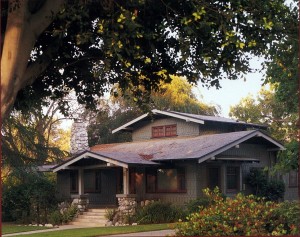By Michelle Gringeri-Brown
 In our last installment, we followed our publisher’s adventures in choosing exterior point colors and preparing American Bungalow’s publishing office, the Twycross House, for a new paint job. In this episode, we ask the rhetorical question, What could go wrong?
In our last installment, we followed our publisher’s adventures in choosing exterior point colors and preparing American Bungalow’s publishing office, the Twycross House, for a new paint job. In this episode, we ask the rhetorical question, What could go wrong?
John Brinkmann received four bids from painters on the exterior paint job. Several professionals suggested prepping the peeling portions, applying heavy primer to help camouflage the cracks and uneven surfaces, and spraying on a new top coat. But he was reluctant to go the standard route, feeling that the texture of the cross-cut shingles and beams would be further lost under more gloppy paint.
Brinkmann decided to use CDS, Inc. in nearby Alhambra. Calif., whose coowner, Dean Tweedy, suggested attractive alternatives—although he came in with the highest bid. After calculating the countless man-hours that would be required to take the whole house down to bare wood, they compromised by deciding to strip the bungalow’s street facade and two sections near the back porch, along with the south wall of the garage—the areas in the worst condition.
Tweedy specializes in restoration and specialty coatings. He recommended a special abrasive wheel that he felt would remove the paint without damaging the wood. The paint laughed. A test section proved that the half-dozen paint layers were more tenacious than that. Next up was a peel-away stripper that promised to remove all of the paint layers in one fell swoop.
Tweedy had used this product on other old homes with good results. But Mrs. Twycross’ old-formula paint was unimpressed. Some portions stripped away neatly as advertised, while in other areas, the product only worked spottily. And it wasn’t inexpensive by any measure: just the stripping product for the areas where the peeling was the worst cost more than $1,000, without any labor. Ultimately, about 20 percent of the bungalow was down to raw wood.
Tweedy contacted the manufacturer about the stripping difficulties. They sent out a customer service rep albeit several months later. delaying the job further. Their product comes in several different versions, and they presumed that the wrong formula being applied. However, testing sample sections soon showed that right product was in use—it just took multiple applications to remove paint.
Prep. Prep and More Prep
As a result of using the chemical stripper, the shingles needed to be neutralized with water before applying any paint products. The foundation plants that were the recipients of this runoff took a dim view of the proceedings, although
the product—which was sold as non-toxic—wasn’t supposed to harm plants. Many turned up their toes and died. To add insult to injury, other plants were damaged when the chimney, porch, and stone foundation were sandblasted.
Tweedy’s crew took great pains to prep the wooden screens and windows. An early plan to remove the windows
and run them through a planer proved unworkable, so disk and belt sanders came into play. Corner gaps between the rough-sawn shingles were caulked and a tinted primer coat applied to the body. Then the real fun began.
“When all of the body had been painted, blotches appeared in several areas,” Brinkmann remembers. “And then the touch-up wall color was different. Eventually the Dunn- Edwards paint rep came out to see what the problem was. They had done a great job matching the color samples I’d given them initially, but now there seemed to be a variation between the batches.” The upshot was that Dunn-Edwards paid CDS to repaint the whole body during the Christmas holidays of 1998.
What Schedule?
The remainder of the job proceeded with only minor mishaps, although CDS undoubtedly took a bath on what was turning out to be a year-long project. To Tweedy’s credit, he never raised the price, but not surprisingly enthusiasm for completion was in short supply.
Brinkmann had planned to use high- or semi-gloss paint on the trim, but a test window showed that the uneven, feathered-paint surfaces were even more obvious with a glossy coat. “That caused us to go with flat paint on all of the surf aces—something I’d never do again” he says now. “Somehow, the flat on the window sills really shows the dust and it constantly looks dirty.”
And the paint job is still presenting challenges: The body color is mottled in many areas, with what looks like chemical reactions taking place—not unlike a watercolor wash. “Within 14 months, we were looking at heavy touchups to the body. if not repainting,” Brinkmann says. “And portions of the front porch are peeling—I’m not sure why.” Dunn-Edwards responded to the ongoing problems by offering to repaint with a new contractor. At press time. sections were still being tested in an effort to find suitable solutions to the peeling and color problems.
Challenges, struggles and teeth grinding aside, the house looks great—particularly from the vantage point of passersby. “The color scheme really changed the way the house looks on the lot,” Brinkmann says. “Removing some of the foundation plantings was actually beneficial. It lets you see the bones of the house more, and the dark eaves and window accents make the details come alive.”
Still to Come
Brinkmann lists refinishing the front door, installing Chris Ether light fixtures and a handsome mailbox, along with hardware restoration as still- pending items on the exterior redo. Major landscaping plans for the triple-wide lot are in the offing, and perhaps a wrap-around extension of the porch that would mimic its 1914 design. And what about the gutters that were recommended in our first installment? Should he re-engineer the original built-in system? Would copper gutters and downspouts be an overstatement on this modest builder- designed house? Lots to ponder.
And then there’s the interior. Brinkmann would love to take the plaster arch between the living room and dining room back to its original conformation, and maybe install French doors in one of the former bedrooms that would open out onto a shady, wisteria-draped seating area.
Isn’t nice to know that our American bungalow is just like yours? A place of comfort and great joy, while a never-ending source of projects and potential.
 More Bungalow Paint Palettes
More Bungalow Paint Palettes
Benjamin Moore & Co. has several color brochures that would be helpful for bungalow owners. Colors from nature are grouped in pleasing combinations—especially the Mountain. Prairie and Desert combos—in their txterior Inspiration brochure, as well as their Historical Color Collection. See your local point store for copies, or visit their website, www.benjaminmoore.com.
Dunn-Edwards did custom-color matching for this story’s exterior point scheme. but many of their existing hues would be appropriate for period homes. Their distributors are located in the Southwest, to find a supplier near you, visit www.dunnedwards.com.
The Glidden Co. also has great colors for bungolows. Ask to see the historical section of their Master Palette, or log onto www.glidden.com. Call l-800-GLIDDEN for a supplier in your area.


Recent Comments